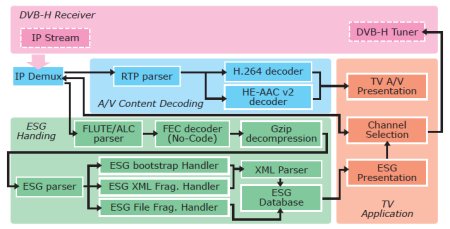DVB-H technology supports Linux devices
May 26, 2006 — by LinuxDevices Staff — from the LinuxDevices Archive — 4 viewsCyberLink and Siano Mobile Silicon have teamed up to create hardware/software technology that will allow devices running embedded Linux to receive DVB-H video. The combo ties CyberLink's DVB-H software suite with Siano's digital TV receiver-demodulater chipset packaged in an SDIO dongle.
DVB-H offers an “improved end user experience” relative to current video streaming services over cellular networks, according to the DVB Project consortium. DVB-H field trials began last year in the U.S. and several European countries, and widespread DVB-H roll-out is expected to begin this year, the consortium says.
SMS1000 chipset
The “highly integrated” SMS1000 chipset implements a CMOS receiver for Mobile Digital TV (MDTV) applications, according to Siano. The input to the chipset is the broadcasted RF signal from the antenna, and the output is a demodulated stream of either MPEG transport packets or IP datagrams, depending on the broadcast standard in use. This data goes to a host processor capable of decoding and displaying MPEG4 and H.264 data streams. The 2-chip set supports multiple broadcast standards on four RF bands and provides several digital output options to the applications processor.
Siano CEO Alon Ironi stated, “The SMS1000, which is now in mass production, is the best choice of receiver chip for designing products supporting mobile TV, allowing designers to obtain high quality reception of multiple TV formats, at the lowest power consumption.”
CyberLink DVB-H software stack
According to CyberLink, its DVB-H software suite includes functionality for:
- Tuning the DVB-H receiver, in this case the SMS1000
- Decoding HE-AAC v2 audio and H.264 video streams provided by the receiver
- Parsing and displaying XML-based electronic services guide (ESG) data

CyberLink DVB-H software architecture
The software runs on ARM-based CPUs and requires 16 MB of memory. It also requires the services of a “smart device” OS such as Linux, Windows Mobile, or Windows CE, the company adds.
“Mobile TV is a major trend in the way consumers access digital television,” said Alice H. Chang, CyberLink's CEO. “Through our close cooperation with Siano, and our relationships with leading industry broadcast content and hardware providers, CyberLink is delivering a market-ready product for handheld makers.”
CyberLink and Siano Mobile Silicon will demonstrate the DVB-H combo at next month's Computex tradeshow in Taipei. The demo will consist of the SMS1000 on an SDIO dongle plugged into a PDA running Mobile 5.0, along with CyberLink's DVB-H TV software stack.
This article was originally published on LinuxDevices.com and has been donated to the open source community by QuinStreet Inc. Please visit LinuxToday.com for up-to-date news and articles about Linux and open source.